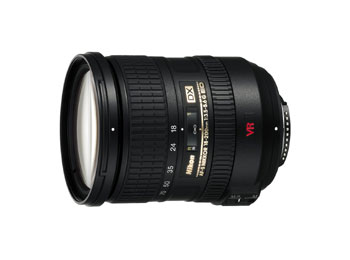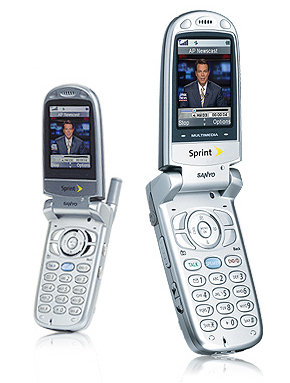 |
||
|
||
| ||
Fabric7 Introduces 16-Way AMD Opteron-Based Enterprise Servers Transcend To Release 8GB Flash Drive And CompactFlash Card Sprint And SANYO Launch New MM-9000 Phone For Sprint EV-DO Network Apacer Introduces New DDR333 4GB ECC Registered DIMM Module Nikon today introduced the new D200 digital SLR camera designed for demanding photographers. According to the press release, the novelty combines new technologies with features inherited from Nikon D2X professional digital SLR. It employs a newly developed 10.2 effective megapixel Nikon DX Format CCD image sensor, 1005-pixel 3D Color Matrix Metering II system, advanced Nikon image processing engine. The D200 powers up in 0.15 seconds, and has 50 millisecond shutter release lag time. It can shoot 5 frames per second with a shortened viewfinder blackout time of 105 milliseconds between shots. The viewfinder offers 0.94x magnification, while a new 2.5 inch LCD screen provides 170 degrees viewing angle from all directions. More features include 11-area autofocus system, Nikon's i-TTL Creative Lighting System and advanced Wi-Fi image-transmission options.  The 10.2 effective megapixel image sensor on the D200 incorporates a high-speed 4-channel data output and a new Optical Low Pass Filter that reduces moire as well as color fringing and shifting. Furthermore, 4-channel output allows the D200 to inherit the advanced image-processing engine of the Nikon D2x professional digital SLR that combines color-independent preconditioning prior to A/D conversion with advanced digital image processing algorithms. Photographers can also fine tune image characteristics such as sharpness, tone, color, saturation, and hue, and select from preset options like Normal, Softer, Vivid, More Vivid, Portrait and Black-and-White. According to the press release, one of the most notable new features of the D200 is its all new 11-area AF system, convertible to a 7-wide area AF system, both based on Nikon's advanced Multi-Cam 1000 AF Sensor Module. It allows an individual area to be selected from either the 11-area AF or 7-wide area AF sensors for Single AF or making use of multiple sensors to enable Dynamic AF, Closest Subject Priority Dynamic AF and Group Dynamic AF.  The D200 is claimed to have capacity of up to 1800 shots per charge. It features an intelligent power management Fuel Gauge that constantly monitors the battery's precise remaining power in 1% increments. It also displays the total number of shots taken on each charge as well as overall life of the battery. The D200 features Nikon's advanced i-TTL wireless Speedlight control built right into the camera, as well as wireless image transfer over an 802.11b/g Wi-Fi network built into the optional WT-3 Wireless Transmitter (available Spring 2006). The camera's built-in Speedlight, capable of coverage for lenses as wide as 18mm, features a Commander Mode that can wirelessly control up to two separate groups of an unlimited number of i-TTL speedlights such as the SB-800, SB-600 or SB-R200. The Commander Mode in the D200 can adjust flash compensation settings for each of the two groups on the fly. The company also added the new 18-200mm F/3.5-5.6g IF-ED AF-S DX VR Zoom-Nikkor lens (27-300mm lens in 35mm format) to its DX Nikkor line of lenses. The novelty is a compact, lightweight 11.1x zoom lens for everyday photography. It incorporates features such as Nikon's Extra Low Dispersion (ED) glass, Silent Wave Motor technology (SWM), Enhanced Vibration Reduction (VR II), Internal Focusing (IF) design, Super Integrated Coating (SIC), in a DX-Nikkor design engineered exclusively for use with Nikon DX format digital SLR cameras.  Finally, today the company also introduced two new Wireless Close-Up Speedlight Systems, the R1C1 and the R1, both designed for Nikon's i-TTL Wireless Creative Lighting System. The R1C1 consists of two SB-R200 Wireless Remote Speedlights, the SU-800 Wireless Speedlight Commander, and an SX-1 Attachment Ring that is used to attach the two SB-R200s to the front of the lens. Additionally, the outfit contains a comprehensive assortment of accessories to help users master and enjoy close-up flash photography, including the SW-11 Extreme Close-Up Positioning Adapter, SJ-R200 Color Filter Set, SW-12 Set Diffuser, SW-C1 Flexible Arm Clip and a set of five adapter rings to ensure the SX-1 Attachment Ring can be mounted on virtually any Nikkor lenses designed for close range photography.  The D200 will be available in late December 2005 for an estimated selling price of $1699.95. The 18-200mm f/3.5-5.6G IF-ED AF-S DX VR Zoom-Nikkor lens will be available beginning in December 2005 for an estimated selling price of $699.95. The Nikon R1C1 and R1 Wireless Close-Up Speedlight Systems will be available in December 2005 for an estimated selling price of $680.00 and $430.00 respectively. The Nikon SU-800 Wireless Speedlight Commander and SB-R200 Wireless Remote Speedlights will also be available individually in December 2005 for an estimated selling price of $265.00 and $155.00 respectively. Source: Nikon
Fabric7 Introduces 16-Way AMD Opteron-Based Enterprise Servers
The Fabric7 Q160 server is generally available now with a starting list price of $144,000. The Fabric7 Q80 server is currently available for customer trials and will be generally available in January 2006 with a starting list price of $42,000. Source: Fabric7 Systems
Transcend To Release 8GB Flash Drive And CompactFlash Card Transcend is due to release its latest Ultra-Speed JetFlash 2A USB 2.0 Flash Drive and an 80X Ultra Performance CompactFlash Card later this month with capacity of 8GB.
The JetFlash 2A comes with a hook and neck strap to keep it from getting lost and to make it easier to remove from USB ports. An LED indicates data transfer activity and a mechanical write-protection switch completes the 8GB JetFlash 2A’s physical features. Inside, the dongle comes bundled with some software, including password protection, PC-Lock (use the JetFlash 2A as a key to your computer), Boot-Up (makes your JetFlash 2A a bootable device) and partition software. The JetFlash 2A supports Windows 98SE/2000/Me/XP, Mac OS 9.0 or later, and Linux Kernel 2.4 or later.
This CF card can achieve average read/write speed of up to 12MB/sec, features built-in ATA interface, built-in dynamic defect management and error correction technology, and supports UDMA. Source: Transcend
Sprint And SANYO Launch New MM-9000 Phone For Sprint EV-DO Network Sprint and SANYO announced the introduction of the Sprint Power Vision Phone MM-9000 by SANYO. The phone enables customers to access Sprint data services, including high quality music, live TV, high-resolution digital imaging, fast Web browsing and On Demand information for news, sports, weather and more, all at broadband-like speeds on the Sprint Power Vision Network. MM-9000 by SANYO is one of the first phones available from Sprint that enables customers to access the Sprint Music Store, claimed to be the first mobile music storefront in the United States that allows wireless customers to browse, preview, buy, download and play full-length songs right from the phone. Like a portable MP3 player, the Sprint Music Store lets customers sample tracks and organize their music using customized playlists.  The phone offers a built-in MP3/AAC/AAC+ player, a 1.3 megapixel camera, a removable miniSD memory card and streaming media capability. The MM-9000 by SANYO is available in Sprint Stores and online for $379.99 or $229.99 after rebate. The phone comes packaged with a stereo headset, a 16MB removable miniSD memory card and miniSD to SD adapter and a USB cable for printing photos directly from the phone to any PictBridge-enabled printer. Source: SANYO
Apacer Introduces New DDR333 4GB ECC Registered DIMM Module Apacer has released a DDR333 4GB ECC Registered DIMM memory module specially designed for AMD Socket 940 high-end servers and workstations.  Grace Lo, Senior Director of Apacer's DRAM Department, mentions that this DDR333 4GB ECC Registered DIMM uses chip stacking technology, which gives each module a 4GB size for the high-capacity memory needs of servers and workstations. Also, in order to improve the performance of the module, Apacer designed the PCB layout to more evenly distribute heat and also reduce signal interference. Source: Apacer
Write a comment below. No registration needed!
|
Platform · Video · Multimedia · Mobile · Other || About us & Privacy policy · Twitter · Facebook Copyright © Byrds Research & Publishing, Ltd., 1997–2011. All rights reserved. |